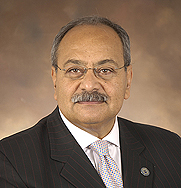Nabil Grace, LTU – Building Better Bridges
 Discussions about our failing infrastructure seem to dominate the nightly news.
Discussions about our failing infrastructure seem to dominate the nightly news.
Nabil Grace, a structural engineer at Lawrence Technological Universiy, is one of the people working on solutions to this important issue.
Dr. Nabil Grace’s specialization is structural engineering. He is the director of the Center for Innovative Materials Research (CIMR) at Lawrence Technological University, a multimillion dollar facility dedicated in 2008. This dynamic facility offers students a variety of applied research opportunities and, at this time, is primarily devoted to the investigation of the use of composite materials in concrete structural applications and for defense applications.
Dr. Grace’s research interests include application of carbon fiber composites to structural engineering, assessment of dynamic behavior of composite automobile components, environmentally dependent behavior of composites, and infrastructure rehabilitation using composite materials. His research activities have attracted some $15 million in private, state, and federal grants, and have been implemented in the design and construction documents for the first CFRP prestressed highway bridge in the United States. Additional highway bridges using these unique solutions are in development.
Dr. Grace received his master’s and Ph.D. in civil engineering from the University of Windsor, Ontario, and his bachelor’s degree from Cairo University.
Building Better Bridges

Now that rebuilding our nation’s infrastructure has become a top priority, we should reconsider how we build highway bridges for cold climates. When salt and water interact with the conventional steel rebar used to reinforce bridge components, the result is serious corrosion that leads to costly maintenance and potential replacement.
Our research has demonstrated that replacing steel with carbon fiber reinforced polymer will eliminate corrosion. We can double the service life span of highway bridges to 100 years and greatly reduce maintenance. Carbon fiber initially costs more than steel but will save considerable money over time.
As a result of our research, carbon fiber has been deployed in five highway bridges in Michigan. Our research team is collecting performance data from these bridges in order to develop new design guidelines for highway bridges. These results are being shared with other states.
Proposed new designs are tested in our environmental loading chamber that can simulate years of service in a wide range of weather conditions. Another test can measure the long-term loss of tensile strength of the carbon fiber rebar caused by traffic. A fire/loading chamber evaluates heat damage.
Analyzing data collected in the field and in the lab will help us achieve better designs for highway bridges that provide better driving conditions and save taxpayer dollars.


